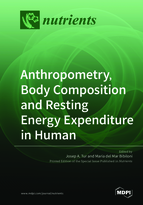Anthropometry, Body Composition and Resting Energy Expenditure in Human
A special issue of Nutrients (ISSN 2072-6643).
Deadline for manuscript submissions: closed (15 February 2019) | Viewed by 67523
Special Issue Editors
Interests: human nutrition; obesity; clinical trials; adults; children
Special Issues, Collections and Topics in MDPI journals
Special Issue Information
Dear Colleagues,
Data on nutritional status of human populations are periodically needed, as well as their relationships with anthropometry, body composition, body image and energy expenditure, and also with health lifestyle outcomes. All these parameters contribute jointly to give a complete knowledge on dietary and lifestyle habits, and hence how to proceed to improve it in order to enjoy an optimal healthy status. So, you are kindly invited to submit proposals for manuscripts that fit the objectives and the topics of this Nutrients Special issue.
The aim of this proposed Nutrients Special Issue on "Anthropometry, Body Composition and Resting Energy Expenditure in Humans" is to publish selected papers detailing specific aspects of anthropometric, body composition and energy expenditure data in human populations and their relationships with nutritional status, as well as nutritional surveys and trials that examine measured differences or changes in these parameters are also cordially invited.
Prof. Dr. Josep A. Tur
Dr. Maria del Mar Bibiloni
Guest Editors
Manuscript Submission Information
Manuscripts should be submitted online at www.mdpi.com by registering and logging in to this website. Once you are registered, click here to go to the submission form. Manuscripts can be submitted until the deadline. All submissions that pass pre-check are peer-reviewed. Accepted papers will be published continuously in the journal (as soon as accepted) and will be listed together on the special issue website. Research articles, review articles as well as short communications are invited. For planned papers, a title and short abstract (about 100 words) can be sent to the Editorial Office for announcement on this website.
Submitted manuscripts should not have been published previously, nor be under consideration for publication elsewhere (except conference proceedings papers). All manuscripts are thoroughly refereed through a single-blind peer-review process. A guide for authors and other relevant information for submission of manuscripts is available on the Instructions for Authors page. Nutrients is an international peer-reviewed open access semimonthly journal published by MDPI.
Please visit the Instructions for Authors page before submitting a manuscript. The Article Processing Charge (APC) for publication in this open access journal is 2900 CHF (Swiss Francs). Submitted papers should be well formatted and use good English. Authors may use MDPI's English editing service prior to publication or during author revisions.
Keywords
- Anthropometry
- Body composition
- Body image
- Body Mass Index
- Free fat mass
- Body fat
- Nutritional status
- Dietary influences
- Health outcomes
- Lifestyle outcomes








